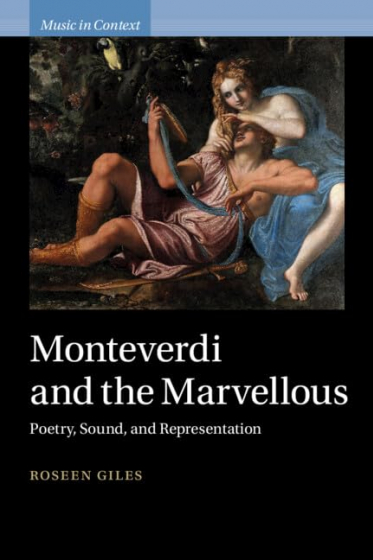Creating Musical Wonderment: Roseen Giles’ Monteverdi and the Marvellous

When was the last time a song hit you in the solar plexus, taking your breath away with wonderment?
You probably didn’t stop to analyze what it was about that song, the artistry of that composition, that evoked such a deep emotional response. But if you were a composer at the turn of the 17th century, like Claudio Monteverdi (1567-1643), pondering this question might have kept you up at night.
In her new book, Monteverdi and the Marvellous: Poetry, Sound, and Representation, Assistant Professor of Music Roseen Giles examines the ways in which Monteverdi skillfully used the musical language of his time to evoke meraviglia, the “marvellous,” a desirable but elusive quality that represented the pinnacle of artistic achievement.
We talked with Giles to learn more about the ways in which Monteverdi created a new relationship between text and music in his compositions. This interview has been lightly edited for length and clarity.
What was meant by meraviglia, the “marvellous,” and do you think there’s a modern equivalent we value in artistic creations today?
The reason why meraviglia (wonderment, astonishment, curiosity) was so controversial in art criticism of Monteverdi’s time is because it is a concept equally concerned with the subject of a poem or piece of music as it is about the listener’s reactions to that piece. While the latter — the effect on the listener or reader — was considered essential since the time of the ancient Greeks, some early 17th century poets and critics made the leap to say that wonderment was the most important facet of a good poem. This had consequences for the music which set it.
It’s hard to say what a modern equivalent of meraviglia would be, particularly since we are so saturated with ‘astonishing’ and ‘shocking’ things in our technological landscape. But true wonderment wasn’t just about ‘shock value’ or an addictive kind of antidote to distraction, it was something that truly made one stop in their tracks, and reconsider what they thought they understood. It was supposed to be a kind of humbling, thought-provoking experience that encouraged a more compassionate approach to the unknown and to places, people and ideas that are unfamiliar.
You write about Monteverdi creating a sense of the “marvellous” through a manipulation of the listener’s sense of time. To illustrate this, you present a fascinating discussion around kisses. Why were poets so interested in different types of kisses and why were kiss poems attractive to composers who wanted to explore the manipulation of time through musical setting?
Kisses are paradoxes. Since the time of the ancient Greeks, poets have been fascinated with them and the way they represent both the inducement and the antidote to desire. In music, this paradox seems to be amplified.
Take, for example, a poem by Battista Guarini, “Con che soavità,” that Monteverdi set for solo soprano and a magnificent nine instruments in his Seventh Book of Madrigals from 1619. In this poem the poet tells of the tragedy that the sounds of pleasurable words can’t co-exist with pleasurable kisses since they share the same source: the beloved’s mouth. You can’t talk and kiss at the same time (one hopes). Except that in music, which is polyphonic (multi-voiced), you actually can. Monteverdi has the soprano interact with different groups of the instruments to convey the ‘armonia’ (music) and ‘detti’ (words) of kissing simultaneously.
You also discuss Monteverdi’s musical treatment of epic poems and how he used multi-voiced settings to represent characters in unexpected ways. How did he do this and why?
Epic verse is very different from much of the lyric verse that composers of the 16th and 17th centuries tended to set to music. Not only do epic verses, which originate in the great stories of Homer and Virgil, focus on narratives, they combine it with the speech and thoughts of actual characters. This push and pull between stories told in real time by the characters themselves and the more meta-temporal perspective of the narrator is something that seemed to fascinate Monteverdi. Most composers of Monteverdi’s time shied away from these kinds of complexities: does a singer represent a character? Or does the perspective they represent, alone or with other singers, change over the course of the piece?
Monteverdi plays with perspective in several interesting ways. Through music, he could convey the complexities of events which happen in time, are experienced differently by different characters, are re-thought and in some cases re-lived after the fact, both by the characters themselves and by the narrator. These pieces are a fascinating nexus of storytelling, emotion, and interpersonal interaction.
What attracted you to this era of music history and what would you like modern listeners to understand about it?
I think one of my central fascinations with this repertory is how unfamiliar it can be in terms of style and technique (it is over 400 years old, after all), while conveying emotions and experiences in a way that seems very familiar. It takes a lot of patience to get to know the music of the past, but this music seems to provoke curiosity in its balance of the (un)familiar, and this can lead to surprising new insights.
If you could recommend one recording of Monteverdi’s works to someone unfamiliar with his music, what would it be?
There are so many wonderful recordings of Monteverdi’s music, mostly because he seems to hold as much fascination for scholars as he does for performers. La Compagnia del Madrigale has some very fine recordings, while Les Arts Florissants and Concerto Italiano have endeavored to make a complete cycle of recordings of all Monteverdi’s madrigals.
For links and further insights, readers can refer to my post for Cambridge University Press’s blog Fifteen Eighty Four.

